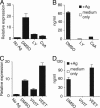Signals from OX40 regulate nuclear factor of activated T cells c1 and T cell helper 2 lineage commitment
- PMID: 16501042
- PMCID: PMC1450148
- DOI: 10.1073/pnas.0600205103
Signals from OX40 regulate nuclear factor of activated T cells c1 and T cell helper 2 lineage commitment
Abstract
T cell helper type 2 (Th2) differentiation is driven by a source of IL-4 receptor (IL-4R) that mobilizes IL-4R signaling pathways and the transcription factor GATA-3. Naïve CD4 cells can secrete IL-4 independently of IL-4R signals, but how this secretion is regulated is not understood. Here we demonstrate that costimulation through the tumor necrosis factor receptor family molecule OX40, in synergy with CD28, is essential for high levels of nuclear factor of activated T cells c1 to accumulate in the nucleus of a recently activated naïve T cell. This action is not dependent on either IL-4R or IL-2R signals and results in OX40 controlling initial naïve T cell IL-4 transcription. OX40 signals subsequently enhance nuclear GATA-3 accumulation through an IL-4R-dependent action, leading to Th2 differentiation. These data show that, in the absence of an exogenous source of IL-4, OX40 provides a critical synergistic and temporal signal with other noncytokine receptors to modulate nuclear factor of activated T cells c1 and to promote optimal Th2 generation.
Conflict of interest statement
Conflict of interest statement: No conflicts declared.
Figures






Similar articles
-
OX40 signals during priming on dendritic cells inhibit CD4 T cell proliferation: IL-4 switches off OX40 signals enabling rapid proliferation of Th2 effectors.J Immunol. 2005 Feb 1;174(3):1433-7. doi: 10.4049/jimmunol.174.3.1433. J Immunol. 2005. PMID: 15661901
-
OX40 costimulation enhances interleukin-4 (IL-4) expression at priming and promotes the differentiation of naive human CD4(+) T cells into high IL-4-producing effectors.Blood. 1998 Nov 1;92(9):3338-45. Blood. 1998. PMID: 9787171
-
CD28 costimulation accelerates IL-4 receptor sensitivity and IL-4-mediated Th2 differentiation.J Immunol. 1999 Sep 1;163(5):2432-42. J Immunol. 1999. PMID: 10452978
-
IL-4-induced GATA-3 expression is a time-restricted instruction switch for Th2 cell differentiation.J Immunol. 2004 May 15;172(10):6158-66. doi: 10.4049/jimmunol.172.10.6158. J Immunol. 2004. PMID: 15128803
-
Role of OX40 signals in coordinating CD4 T cell selection, migration, and cytokine differentiation in T helper (Th)1 and Th2 cells.J Exp Med. 2000 Jan 17;191(2):201-6. doi: 10.1084/jem.191.2.201. J Exp Med. 2000. PMID: 10637265 Free PMC article. Review. No abstract available.
Cited by
-
NFATc1 in CD4+ T cells and CD11c+ dendritic cells drives TH2-mediated eosinophilic inflammation in allergic asthma.J Allergy Clin Immunol Glob. 2024 Oct 18;4(1):100355. doi: 10.1016/j.jacig.2024.100355. eCollection 2025 Feb. J Allergy Clin Immunol Glob. 2024. PMID: 39629220 Free PMC article.
-
Innate signals from Nod2 block respiratory tolerance and program T(H)2-driven allergic inflammation.J Allergy Clin Immunol. 2010 Dec;126(6):1284-93.e10. doi: 10.1016/j.jaci.2010.09.021. Epub 2010 Nov 4. J Allergy Clin Immunol. 2010. PMID: 21051079 Free PMC article.
-
Enhancing the safety of antibody-based immunomodulatory cancer therapy without compromising therapeutic benefit: Can we have our cake and eat it too?Expert Opin Biol Ther. 2016;16(5):655-74. doi: 10.1517/14712598.2016.1152256. Epub 2016 Feb 25. Expert Opin Biol Ther. 2016. PMID: 26855028 Free PMC article. Review.
-
CD4 cell-secreted, posttranslationally modified cytokine GIF suppresses Th2 responses by inhibiting the initiation of IL-4 production.Proc Natl Acad Sci U S A. 2008 Dec 9;105(49):19402-7. doi: 10.1073/pnas.0810035105. Epub 2008 Nov 26. Proc Natl Acad Sci U S A. 2008. PMID: 19036925 Free PMC article.
-
Toward Small-Molecule Inhibition of Protein-Protein Interactions: General Aspects and Recent Progress in Targeting Costimulatory and Coinhibitory (Immune Checkpoint) Interactions.Curr Top Med Chem. 2018;18(8):674-699. doi: 10.2174/1568026618666180531092503. Curr Top Med Chem. 2018. PMID: 29848279 Free PMC article. Review.
References
-
- Moser M., Murphy K. M. Nat. Immunol. 2000;1:199–205. - PubMed
-
- Jankovic D., Kullberg M. C., Hieny S., Caspar P., Collazo C. M., Sher A. Immunity. 2002;16:429–439. - PubMed
-
- Kurata H., Lee H. J., O’Garra A., Arai N. Immunity. 1999;11:677–688. - PubMed
-
- Zhu J., Min B., Hu-Li J., Watson C. J., Grinberg A., Wang Q., Killeen N., Urban J. F., Guo L., Paul W. E. Nat. Immunol. 2004;5:1157–1165. - PubMed
Publication types
MeSH terms
Substances
Grants and funding
LinkOut - more resources
Full Text Sources
Other Literature Sources
Molecular Biology Databases
Research Materials

